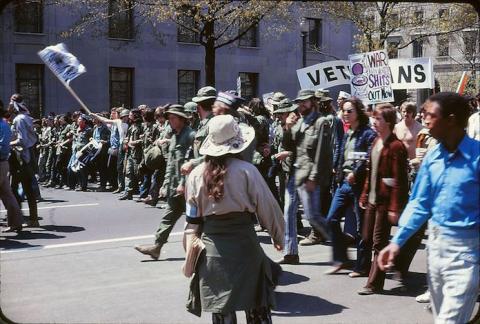A waste of time, money, and energy. Boring. Ineffective.
These arguments against national protest marches appear whenever an organization calls for a major mobilization. On cue, they resurfaced following Dustin Guastella’s proposal in Jacobin for a national Medicare-for-All march.
The Left has deployed this tactic for the past one hundred years, and we should acknowledge that it doesn’t produce direct change.
The hundreds of thousands who descended on Washington in 1969 didn’t stop the Vietnam War. That happened six years later, when national liberation armies took Saigon. When a million people came to New York to demand a nuclear weapons freeze in 1982, the arms race didn’t end. January’s Women’s March has had no apparent impact on Donald Trump’s presidency.
No organization ever marched right to its goal, because that’s not what marches are for. National mobilizations do not produce results overnight. Instead, they reveal an idea’s influence, decisively changing the national conversation.
Consider, for example, the 1963 March on Washington. We remember it not only for Martin Luther King’s famous speech, but also for the national consensus around the Civil Rights Movement it forged. Until then, citizens debated the movement’s goals, and many felt it represented, at most, a Southern problem. The march broke through that.
Two years later, another march on Washington drew a smaller crowd, but it also changed the course of history.
By 1965, the Vietnam War was escalating. Lyndon B. Johnson, flush from his landslide victory over Barry Goldwater, enjoyed overwhelming approval rates. With fresh memories of World War II and Korea, the country still largely supported the war effort. At this moment, Students for a Democratic Society (SDS), the fastest growing radical group since the red scare, decided to plan a national peace march.
The antiwar movement in 1965 mostly was dominated by liberals worried about being labeled un-American communists. There had been a few local demonstrations, but opposition to Vietnam still seemed fringe, even kooky — hence the peaceniks moniker, a twist on the widely mocked beatniks.
Liberals, hard-core anticommunists, and the peace movement’s old guard pushed hard against the march proposal. Groups to SDS’s left welcomed the idea but knew they were too marginal to organize it. SDS chapters, however, were spreading across the country. If anyone could pull off a major antiwar protest, they could.
All the peace organizations that had been floundering around for the last few years … suddenly saw the march as the most important expression against the war, and started hovering around SDS clamoring for joint sponsorship. … Even liberal New York unions, like the Drug and Hospital Workers Local 1199 and the Retail Workers Union District 65, and off-center political groups like the Bronx Reform Democrats, wanted to join in.
The march drew only twenty thousand people — a tiny fraction of those who would participate in later actions — but nevertheless sparked what the ruling class would come to call “Vietnam syndrome.”
In imperialist countries like the United States, citizens typically support their leaders’ war efforts. This was especially true in the United States in the sixties. The nation had the strongest military in history. More people were enjoying capitalism here than anywhere. The Left had all but disappeared in the fifties’ red scare, and the civil rights movement seemed to be the only dent in the imperial armor. The government expected people to rally round the flag for Vietnam: they would face persecution and scorn if they did not.
But, within a few years of that first march, the country was divided over the war as consensus turned into opposition. Bigger mass protests took place. Bloodshed increased, reminding Americans of the costs of war. The culture shifted.
The government could no longer sell the war, and many Americans developed a permanent suspicion of military adventures. The Left had found imperialism’s Achilles’ heel.
Arguably, the SDS antiwar march on Washington launched this sea change. A lot followed: LBJ decided not to run for reelection, King made his historic “Beyond Vietnam” speech, soldiers rebelled, hippie love commandos spread peace, the Chicano Moratorium organized its members into the antiwar movement. A relatively small march laid the foundations for all this history.
Of course, the situation is different today, and trying to repeat history is one of the Left’s most common mistakes. We cannot guarantee that a Medicare march would have a similar outcome.
That said, some of the things that differentiate 2017 from 1965 favor our cause.
Johnson had high approval ratings in early 1965; Trump has historically low figures. In 1965, many workers supported the war and trusted the government. Today, workers are watching their working and living conditions decline and recognize that skyrocketing health-care costs contribute to their misery.
The peace movement was just starting in the spring of 1965, but the single-payer movement has been growing steadily for decades. Unions as well as public — and, increasingly, private — health-care providers support it.
Most importantly, the Medicare-for-All movement unites the most people while casting a harsh light on the center-to-far right, which wants to deny Americans basic health-care coverage. A successful march could build off the growing feeling of resentment and change the political landscape.
As the president’s various scandals preoccupy media attention, we should focus on an issue that responds to what people urgently need and want.
A successful march will demand careful groundwork and intense commitment from activists. It’s a big task, but it’s not like the Left hasn’t done it before.
Ethan Young is a writer/editor in Brooklyn, a member of DSA, Left Labor Project and People for Bernie, and a moderator for Portside.org.


Spread the word